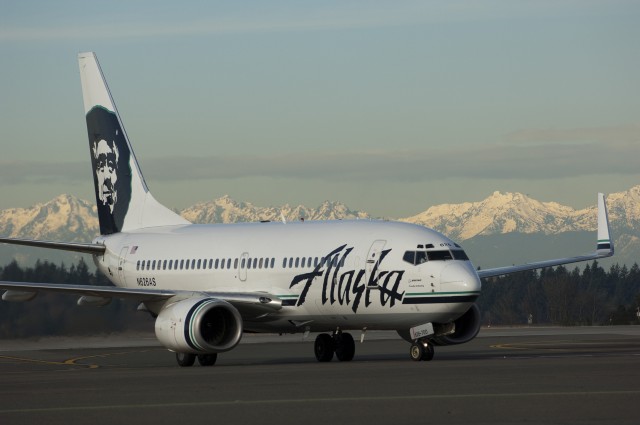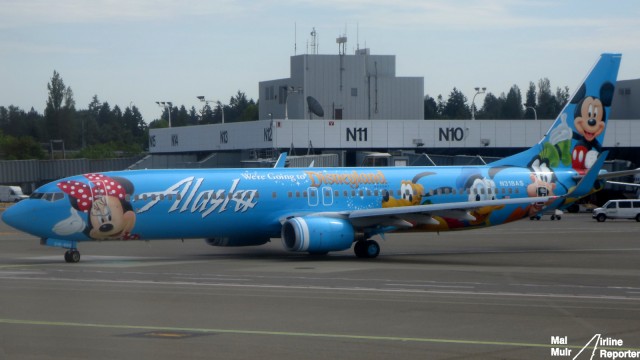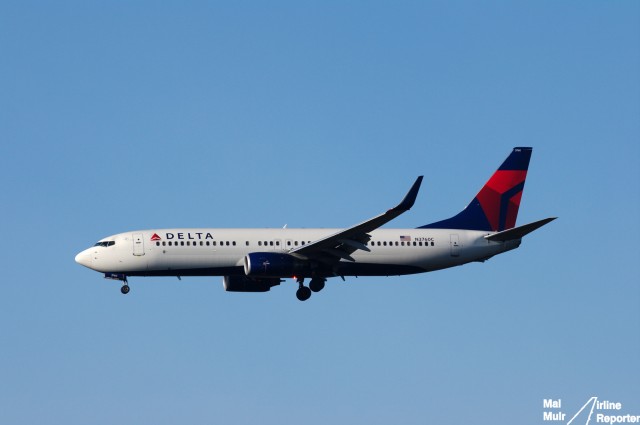So, everybody and their brother has been writing about the recent announcement from Delta Air Lines that they’re further expanding their domestic flight schedule out of Seattle (SEA). There have been stories from mainstream media, miles/points bloggers, and (of course) industry watchers such as ourselves. Yet, we wanted to talk amongst ourselves and digest the information before weighing in.
Why is this a story? It’s because Alaska Airlines (AS), which is based out of Seattle, is supposed to be a partner airline with Delta. All three of the recently announced Delta routes are in direct competition with Alaska; actually 8 of Delta’s 13 domestic routes out of Seattle compete with Alaska.
As a guy who grew up in Washington State, and went to college at the University of Washington, I hold a special place in my heart for Alaska. An all-Boeing 737 operator, they have a loyal following in the Northwest. I just flew Alaska to and from Denver, and enjoyed their solid customer service, low-priced First Class upgrades, and great ground experience out of Seattle. (Although, as seems to be common from Denver, I got stuck on the Disneyland plane – am I the only one freaked out by flying on this bird?!).
Back to the conflicts between Alaska and Delta – it isn’t only about routes. You could say that Alaska is just as guilty, flying to Delta hubs such as Salt Lake City, Minneapolis, and Atlanta, but those routes don’t see high-frequency service from AS (Salt Lake City and Minneapolis are twice-daily, while Atlanta is once-daily). Rather, these new and expanded routes, particularly LAX and SFO, are about frequency and timing. Delta is going to be serving each with seven daily flights, which is especially noticeable in the San Fran market, considering they don’t serve the route now. That boost in frequency certainly raises an eyebrow, but schedule concerns me more.
When you look at my local airport (Denver) you can see United and US Airways (Star Alliance partners) coexisting. US Airways only serves their three hubs from Denver (Phoenix, Philadelphia, and Charlotte), while United serves Phoenix and Philly with their own metal. However, when you look at their daily schedules, their flights are complementary. US Airways and United stagger their departure times throughout the day, enhancing customer options and operating as partners should. In almost every case, there is over an hour between departures from the carriers.
Now look at SEA-LAX with Delta and Alaska. Some of these “partner” flights depart within five minutes of each other. The bulk are within 20-30 minutes. This mirrors other routes too, like Las Vegas. When two airlines’ planes are flying next to each other on a route, that’s not a partnership – it’s competition. What happens when the consumer has multiple choices for the same product (in any industry)? Price goes down. That’s a bad thing for both airlines.
So why is Delta taking this approach? It’s been widely reported that they are building up a west coast transpacific hub out of Seattle, harking back to the Northwest Orient days. While Delta can feed those routes with their partner Alaska, they’d rather have those passengers on their own metal. They also need significant volume to maximize those flights (Delta doesn’t have any Boeing 787 Dreamliners to use on “long and lean” flight to Asia like United does). So while Alaska can continue as a partner and throw some help their way, Delta is going to be the 800 lb. gorilla in the room.
When Alaska was asked about Delta’s recent moves, a spokesperson told AirlineReporter.com, “Las Vegas, Los Angeles, and San Francisco are large markets from Seattle and we’re grateful to have a strong presence in all three of these markets. We added seats between Seattle and Las Vegas this past spring and we increased seats from Seattle to Los Angeles and San Francisco over the summer. We added seats in part to accommodate an increase in demand as we connect passengers into Delta’s growing international flights out of Seattle. As Seattle’s hometown airline, we’ll continue to meet demand in these core West Coast markets.”
What does this leave for Alaska? As I said in a radio interview earlier this week about the American Airlines and US Airways merger, it’s going to be hard for any mid-sized airline to survive head-to-head against the mega airlines like new Delta and new United. Alaska has always been able to count on dominance at its Seattle hub, but Delta is now flying to some sacred markets, like Anchorage.
Is Delta looking to put pressure on Alaska in the interest of a merger or acquisition? I’m not sure if that makes sense and likely will not happen. True, if Alaska was folded in to Delta, Seattle would become a major hub for them (for both international and domestic routes), but what would that mean for Delta’s Salt Lake City hub (a mere 700 miles away, with a much smaller population base)?
Now, everyone is watching what Delta and Alaska will do next. Delta is a very large airline with resources to play hardball, but Alaska is very protective of their territory. This could get interesting and we will be here to see how it plays out.



The Alaska mileage plan benefits (2 free checked bags and 1 $99 companion ticket anywhere Alaska flies per year) are the main reason why I’ll continue to be a loyal domestic customer for Alaska. I used to be a Delta Skymiles member but got sick of all the restrictions and blackout dates on their companion tickets.
Geographically, SLC may make more sense as the continuing Delta domestic hub in the West (assuming Delta buys Alaska). 75% of the airspace around Seattle (excluding the states of Alaska and Hawaii) is in Canada or the Pacific Ocean.
AS leadership lost respect for the Gorilla and they are going to
pay the price. Or….AS could buy a dozen 787s and slap DL back. Anybody in the room rather fly DL to Asia than Alaska?
I appreciate your article–I’m not part of the airline industry, but enjoy your blog and have read other articles on this subject as well. I recall Continental Airlines criticizing Delta’s “partnership” shortly after Delta and Northwest agreed to merge, so you certainly may be on to something.
That said, I think there are other potential reasons for Delta’s new SEA routes. My two cents … do Delta and Alaska have anti-trust immunity? If not, while they can codeshare, I would think there are limits on how closely they can collaborate regarding scheduling and pricing. With Alaska also codesharing with key Delta rival American, I’ve always wondered just how close Delta and Alaska really can get.
Also, I’ve noticed you can’t book any of Delta’s Pacific or Europeon destinations through Alaska’s website. If this results in most of the Alaska feed for Delta’s international service being booked through Delta’s website, Delta may feel it can increase its profits by selling tickets on organic Delta flights. I’m curious why Delta’s west coast “partner” does not actively market Delta’s international desitinations through its website.
Finally, nearly all of Delta’s new flights are regional jets with limited capacity compared to Alaska’s mainline service. Thus, Delta may not be targeting Alaska’s market share, but rather trying to feed its own international service. Today, United seems to have taken notice of Delta’s new flights; it may be their market share that is more at risk.
Alaska probably isn’t too disappointed to move from “partners” to true competitors with Delta. AS is the process of rebranding, including a possible new name, to create a wider reach across the country. I’d guess more destinations and cross-country flights (that compete with current Delta-partner flights) will come along with it. Source: my parent is a 30-year employee.
Alaska Air has a sense of customer service that cannot be taught, and can’t thrive in an environment where bean counters control every move.
I don’t fly that much any more, but when I lived in Portland, I regularly flew Alaska/Horizon up to Seattle for my Asia business trips.
My fondest memory was when I left my beautiful leather jacket (which I still own) in the Norhwest Interntional Departures lounge in Seattle before getting on a flight down to Portland. Just before we landed, the flight attendant came by my seat and asked me to check in with her once we were on the ground. I did so, and was told they had my jacket (at that point I had forgotten that I even haad it, let alone that it was missing) and it was already in the air on a Horizon flight to Portland, and if I would just go to gate XX, one of the flight attendants on that flight would bring it out to me once all the passengers were off boarded.
I did, they did, and I defy one of the minline carriers to do the same. That, my friends, will be why Alaska will never be unseated in the Northwest.
Cheers